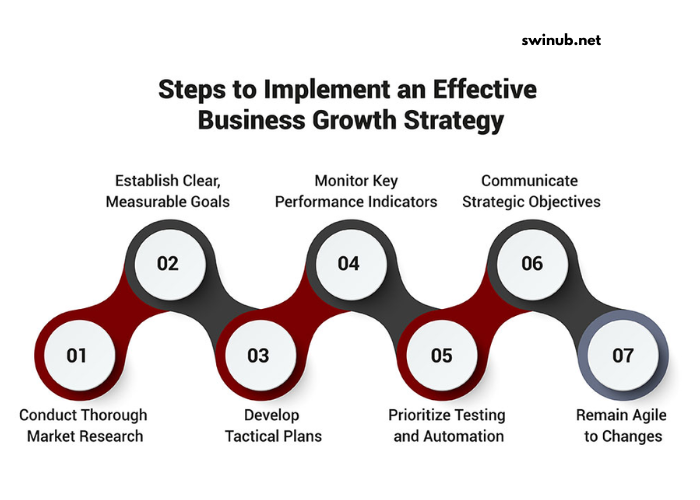In the fast-paced and ever-evolving world of business, achieving long-term success requires more than just a good idea or a strong start. A business needs to have a solid foundation of effective strategies to grow, adapt, and thrive over time. Implementing these strategies can help businesses maintain their competitive edge, meet customer expectations, and foster sustainable growth.
In this article, we will explore several essential business strategies that can lead to long-term success. These strategies encompass everything from building a strong company culture to leveraging technology and optimizing operational efficiency. Let’s dive into the key components that will help ensure your business remains competitive and sustainable.
Understanding Long-Term Success in Business
Before diving into strategies, it’s important to define what long-term success means in the business world. Long-term success is not just about making profits in the short term but about sustaining growth, building strong relationships, and adapting to changes in the market. Businesses that succeed over time are those that can balance profitability with a focus on their mission, vision, and values.
Key Factors That Contribute to Long-Term Success
Long-term business success can be broken down into several critical factors:
- Consistency in Quality: Maintaining high standards for products and services ensures customers trust your brand and remain loyal.
- Adaptability: A successful business can pivot and adjust to market demands and trends.
- Strong Leadership: Effective decision-making, strategic thinking, and vision from leadership play a crucial role in sustaining long-term growth.
- Customer-Centric Approach: Focusing on customer needs, feedback, and satisfaction is vital for building a lasting brand.
- Innovation: Keeping up with technological advancements and industry trends helps businesses stay competitive.
Now, let’s explore the strategies that businesses can implement to ensure these factors contribute to long-term success.
1. Establish a Clear Vision and Mission
Importance of a Strong Vision and Mission
A clear vision and mission statement are fundamental to guiding the overall direction of a business. Your vision defines where you want your company to go in the long run, while your mission outlines the purpose behind your business. Having these elements in place helps employees stay focused on the company’s goals and gives your business a sense of purpose.
A compelling mission and vision also communicate your brand’s values and objectives to customers, investors, and stakeholders, helping to build trust and loyalty over time.
How to Create an Effective Vision and Mission
- Involve key stakeholders: Engage employees and leadership in crafting the vision and mission. This ensures everyone is aligned with the goals and values.
- Be specific and achievable: Set clear, measurable, and realistic goals that are aligned with your company’s capabilities.
- Communicate regularly: Reinforce the vision and mission across all levels of the organization to keep employees motivated and on track.
2. Build a Strong Company Culture
Why Company Culture Matters
A positive company culture is an essential component of long-term business success. It helps attract and retain top talent, improves employee satisfaction, and boosts productivity. A strong company culture also fosters innovation, collaboration, and creativity—qualities that are key to adapting to change and achieving sustainable growth.
Strategies to Cultivate a Strong Company Culture
- Encourage open communication: Establish an environment where feedback and ideas are welcomed and valued. Regular communication fosters trust among employees.
- Lead by example: Leadership should embody the company’s values and demonstrate the desired behaviors. Employees are more likely to follow the example set by their leaders.
- Promote work-life balance: A healthy work-life balance can improve employee morale and reduce burnout, leading to higher retention rates and productivity.
- Invest in employee development: Offering opportunities for professional growth and skill development can help your employees reach their full potential.
3. Focus on Customer-Centric Strategies
Understanding the Importance of Customer Satisfaction
Customers are the lifeblood of any business, and a customer-centric strategy focuses on building strong, long-lasting relationships with them. By prioritizing customer needs and offering exceptional service, businesses can increase loyalty, generate repeat sales, and benefit from positive word-of-mouth referrals.
Tactics to Build a Customer-Centric Business
- Collect and act on customer feedback: Regularly ask for feedback through surveys, reviews, and direct communication. Act on the insights to improve your products, services, and overall customer experience.
- Personalize the customer experience: Use data and technology to offer tailored experiences that meet the specific needs of each customer. Personalization can significantly improve customer satisfaction and retention.
- Be responsive and accessible: Customers value quick, efficient responses. Ensure that your support channels are easily accessible and staffed with knowledgeable, helpful employees.
- Create a loyalty program: Reward returning customers with discounts, special offers, or exclusive access to products or services. This strengthens the relationship and encourages continued business.
4. Leverage Technology and Innovation
The Role of Technology in Business Success
In today’s digital age, businesses must embrace technology to stay competitive. From automation and artificial intelligence to data analytics and cloud computing, technological advancements offer businesses numerous ways to streamline operations, reduce costs, and enhance customer experiences.
How to Use Technology to Drive Long-Term Success
- Invest in automation: Automating routine tasks can free up valuable time for employees to focus on higher-value activities. This can increase productivity and reduce human error.
- Adopt data-driven decision-making: Use data analytics to understand customer behavior, market trends, and operational performance. Data-driven decisions can help businesses stay ahead of the competition.
- Improve cybersecurity: As cyber threats become more prevalent, ensuring robust cybersecurity protocols is crucial for protecting sensitive business data and maintaining customer trust.
- Integrate cloud solutions: Cloud computing offers businesses flexibility, scalability, and cost-efficiency. It enables teams to collaborate more easily and access data from anywhere, improving operational efficiency.
5. Optimize Operational Efficiency
Importance of Streamlining Operations
Operational efficiency is critical to a business’s long-term success. By minimizing waste, improving processes, and optimizing resource allocation, businesses can reduce costs, increase profitability, and improve overall productivity. Efficiency improvements can also help businesses scale more effectively as they grow.
Strategies to Improve Operational Efficiency
- Identify and eliminate bottlenecks: Regularly assess business processes to identify areas where delays or inefficiencies occur. Addressing these issues can lead to faster workflows and better resource utilization.
- Outsource non-core functions: Consider outsourcing tasks that are not part of your core competencies, such as accounting, HR, or IT support. This allows your team to focus on the activities that drive growth.
- Invest in employee training: Well-trained employees are more efficient and effective. Investing in training ensures that your team has the skills they need to perform at their best.
- Monitor key performance indicators (KPIs): Use KPIs to track operational performance and identify areas for improvement. Regular monitoring helps ensure your business stays on the path to success.
6. Emphasize Financial Management and Planning
The Role of Financial Management in Long-Term Success
Strong financial management is crucial for the long-term sustainability of any business. Without proper budgeting, forecasting, and cash flow management, even the most innovative business can face challenges that threaten its survival.
Financial Strategies for Long-Term Success
- Maintain healthy cash flow: Ensure your business has enough liquidity to meet its operational needs and avoid financial crises. Keep track of your cash flow regularly and implement strategies to prevent cash shortages.
- Plan for the future: Create long-term financial plans and forecasts that help you navigate uncertainty and capitalize on opportunities. Strategic planning can guide your business toward sustainable growth.
- Diversify revenue streams: Relying on a single source of income can be risky. Consider diversifying your offerings to reduce dependency on one revenue stream and create more stability.
- Control costs: Regularly review your expenses and find ways to reduce unnecessary costs. This can improve profitability and provide more resources for reinvestment in your business.
7. Foster Strategic Partnerships and Networking
The Power of Partnerships and Networking
Building strategic partnerships and networks can offer businesses new opportunities for growth, collaboration, and market expansion. Partnering with other companies, industry influencers, or thought leaders can provide access to new resources, technologies, and expertise.
How to Leverage Partnerships for Growth
- Collaborate with complementary businesses: Identify businesses that offer products or services that complement your own. These partnerships can help expand your customer base and offer joint value to your audiences.
- Attend industry events and conferences: Networking at industry events helps you stay informed about trends and allows you to build relationships with potential partners or clients.
- Engage in cross-promotion: Collaborate with partners on marketing initiatives, such as social media campaigns, email newsletters, or joint promotions, to increase visibility and reach a broader audience.
Conclusion
Achieving long-term success in business is a dynamic and ongoing process that requires careful planning, adaptability, and consistent effort. By implementing the strategies outlined in this article—such as creating a clear vision and mission, building a strong company culture, focusing on customer satisfaction, embracing technology, optimizing operational efficiency, managing finances, and fostering partnerships—businesses can position themselves for sustainable growth and success.
Ultimately, businesses that focus on long-term goals, adapt to changing environments, and maintain a commitment to quality and innovation are more likely to thrive in today’s competitive market. Keep your eye on the big picture, remain agile in your approach, and continue to refine your strategies to ensure that your business not only survives but flourishes for years to come.


